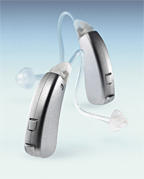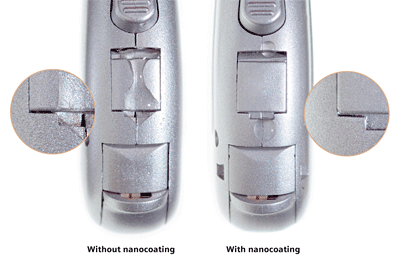Interview with Pam Burton, Siemens Hearing Instruments
Topic: Siemens Mid-Range Digital Hearing Aids
 Dybala: Hello Pam, thanks for sitting down with me.
Dybala: Hello Pam, thanks for sitting down with me.Burton: It is always good to talk with you and the Audiology Online readers, Paul.
Dybala: As a tradition here at Audiology Online we always start off with a short bio sketch, so could you give us a little background on yourself and more importantly what you currently do with Siemens?
Burton: As the Director of Product Management, I am responsible for working with research and development and marketing in developing and introducing new products and product upgrades. Really my group is involved with all Siemens hearing instruments from conception through introduction and throughout the lifetime of that product.
Dybala: Thanks for that. I am talking with you today about the new Siemens Mid-Level hearing instruments ARTIS and CIELO. Products are changing on an almost yearly basis, within the past year Siemens released the premium digital product ACURIS with e2e (ear-to-ear) technology. Just for reference could you run down the Siemens technology pyramid so that we can see where ARTIS and CIELO sit? It would be great if you had one of those nifty pyramid graphics or charts to pull it all together!
Burton: Our product portfolio offers something for everyone from entry-level digital products to our highest-end digital solution, ACURIS. ARTIS and CIELO help Professionals provide their patients with higher level features at a more competitive price. Charts are always good! I have provided a copy of our technology chart in PDF format for your readers to download and view.
View Siemens Hearing Instruments Digital Technology Chart
Dybala: This is side tracking a bit, but how do you come up with your product names and are the names ARTIS and CIELO symbolic of anything? I always thought it would be an interesting job to come up with the names of hearing aids.
Burton: The naming of new products IS an interesting process, and it is the job of the Marketing and Product Management groups to work together toward this global goal for each new development. In some cases, the names do have meanings, either in English or other languages (for example, the definition of CIELO in some languages is "sky" or "heaven"); in others, the names are proposed based on some reference to a characteristic or feature(s) in that product line.
Dybala: I was reading through some of the technical specifications on CIELO, could you give a quick summary of the basic features?
Burton: - We developed CIELO to address the needs of a professional's more value conscious patients - great features at mid-range prices. A 6-channel product line with programmable crossover frequencies, CIELO features an adaptive TwinMic™ directional microphone system, phase cancellation feedback management, and 6-channel digital noise reduction and compression.
Dybala: Adaptive directional microphones down to the ITC style, noise and phase cancellation, a nice collection of features for a mid-range product. You mentioned 6 channels with adjustable crossover frequencies. Just to jump through some semantic hoops, I have heard the terms channels and bands used interchangeably, you are talking about 6 channels of compression and not 6 channels of band frequency shaping, correct?
Burton: CIELO has 6 independent controls for gain across the frequency response. In regard to compression and noise reduction, the signal processing takes place in all 6 channels, however, for programming adjustments, there are 3 handles to address changes in compression characteristics such as kneepoints, ratios and temporal characteristics.
Dybala: Thanks, I feel like I have a "handle" on that now. Any other features?
Burton: CIELO features Wind Noise Reduction and AutoPhone, a switchless telecoil feature, in custom and most BTE models.
Dybala: How does Siemens accomplish wind noise reduction in CIELO?
Burton: It is very exciting to have this feature in a mid-range product, Paul. This is available in any CIELO product with directional microphone capability - this includes the CIELO Dir BTE and any custom model down to ITC which has been ordered with this option. When present, wind is detected easily because the signal is uncorrelated as it reaches the two microphones. Even though CIELO does not have an automatic directional microphone, for a situation like wind, it does have the capability to detect this signal and make the appropriate adjustments. These include the smooth transition to omnidirectional mode and the reduction of very low frequency gain.
Dybala: I used to spend a lot of time working with patients on getting the hearing aid into the right program or switch in the right position for phone use. Tell me a bit more about how AutoPhone works.
Burton: AutoPhone is also a wonderfully flexible feature to have in a mid-range product. The feature can be programmed for activation in a particular program, or programs, as necessary for each patient. A special box in CONNEXX (Siemens fitting software) allows the professional to automatically re-direct the instrument into the desired memory location, programmed specifically for telephone use by the professional. The feature is automatically activated by the patient when used with a hearing instrument compatible telephone.
Dybala: I also saw that you have CIELO Life, an open fitting option. Would I need to order a new instrument, or is this the same hardware and I simply program the device differently and add an earpiece?
 Burton: Our Life products are specially developed for open fittings (smaller, sleeker cases, ultra-thin tubing and soft open canal tips) and would need to be ordered separately. We offer three Life products (ACURIS, ARTIS & CIELO) and each one is unique. CIELO Life does have less gain and output than the other Life models, but it still maintains a wide fitting range to address most mild through moderate, sloping hearing losses.
Burton: Our Life products are specially developed for open fittings (smaller, sleeker cases, ultra-thin tubing and soft open canal tips) and would need to be ordered separately. We offer three Life products (ACURIS, ARTIS & CIELO) and each one is unique. CIELO Life does have less gain and output than the other Life models, but it still maintains a wide fitting range to address most mild through moderate, sloping hearing losses.Dybala: Ok, we will now step up in technology to ARTIS. I would assume that the number of channels increase correct?
Burton: Not only does the number of channels increase to 12, but ARTIS also features an automatic and multi-channel adaptive TwinMic directional microphone system and high speed feedback cancellation. In addition, the Noise Management system employs noise reduction and speech enhancement technology to provide even more advanced signal processing in noisy situations.
Dybala: The multi-channel adaptive TwinMic allows your directional system to simultaneously use different polar plots for different frequencies. Let's say for example, I had a 750 Hz low frequency noise occurring behind me, and a 250 Hz noise coming from beside me, all at the same time. The hearing aid would be able to simultaneously provide a cardiod pattern for the 750Hz noise and a bidirectional pattern for the 250 Hz noise. Correct?
Burton: Yes, that is correct.
Dybala: What are the fitting protocols that are available in ARTIS and CIELO?
Burton: NAL-NL1 is the default First Fit algorithm, but Hearing Care Professionals can select DSL[i/o} as well - both of these algorithms are appropriate for fitting all of our products.
Dybala: Does Siemens have a proprietary fitting algorithm?
Burton: Siemens doesn't have a proprietary fitting algorithm for standard fittings, as both NAL-NL1 and DSL[i/o] are widely verified on hundreds of thousands of fittings. However, we do offer four acclimatization levels for each protocol, which allows the professional to determine how closely they would like to match these popular algorithms. Some of this depends on the patient's hearing instrument experience level.
Dybala: Tell me more about the wireless ARTIS e2e. I can conceptualize how the e2e wireless is able to binaurally control the volume control of both devices. The e2e is supposed to help with directionality, what is the benefit?
Burton: ARTIS e2e is available as a separate product line which offers e2e wireless as an added benefit. The e2e wireless synchronization ensures that the directional mode is matched between instruments at all times. We have seen that improved directionality can result in better localization for the wearer (Byrne & Noble, 1998; Chung & Stephens, 1986). Localization can also be compromised by the wearer due to mismatched volume control settings which do not remain at the same level. With e2e, both volume settings continue to be matched after the fitting to ensure that the loudness balance is always appropriate.
Dybala: Plus, you have an ARTIS Life / open fitting option as well.
Burton: Yes, ARTIS Life is available as the next step up from the CIELO Life. More gain and output is available. There is also more fitting flexibility with 12 channels and the Noise Management system is much more sophisticated to deal with difficult listening situations. Plus ARTIS Life's case is nanocoated.
Dybala: Now, something I have not heard before is that ARTIS BTEs have a nanocoating. What is the science behind nanocoating?
Burton: Nanocoating is a technology that is widely used in other industries, such as dentistry and surgery, to enhance reliability. It is an ultra-thin, anti-adhesive coating that has both oleophobic and hydrophobic properties, that gives the case a high level of water, oil, and dirt repellency.
Dybala: Normally, we would describe hearing aids as oleo- and hydrophobic, having a "fear" of oil and water! What a great way to provide preventative care. This would be useful for any patient who is really active, especially kids. Do you have any pictures that show the difference with and without nanocoating? I would also be curious to see if your repair labs have seen any differences in the repair rates.
Burton: As you can see from the images, the difference is striking. The nanocoating keeps the water in a bead to reduce the odds that this moisture gets into the BTE casing. Reduced moisture inside of the case means less rust and damage to those internal components. As the nanocoated BTEs are just now being introduced, it is too soon to compare repair rates. However, our testing while the process was in development gives us a high level of confidence that this will promote greater reliability.

Dybala: Well Pam, overall it seems as though the Siemens mid-range ARTIS and CIELO give the professional lots of options! I think it is great how we are seeing the trickle down effect of technology over the past few years. Not long ago the devices that we are describing today would have been in the premium digital category! I think this is just great that we can now offer such great value to our patients.
Burton: That is our goal, Paul - to provide enough flexibility with higher-level features and options that give professionals a chance to make fitting decisions based on audiologic needs instead of price, which is a major factor for most patients.
Dybala: Well, thank you for being here today and talking with me about the latest Siemens products!
Burton: As always, thank you for the opportunity. We appreciate it.
Siemens Hearing Instruments, part of Siemens Medical Solutions, is one of the leading manufacturers of hearing aids in the United States. Headquartered in Piscataway, New Jersey, the Company offers a range of innovative products, solutions and services to Hearing Care Professionals across the United States. Among its innovative products, the Company designs and manufactures a variety of digital hearing aids in all styles to improve the quality of life for individuals with hearing loss.
Visit www.usa.siemens.com/hearing for more information.
Works Cited
Byrne, D. & Noble, W. (1998). Optimizing sound localization with hearing aids. Trends in Amplification, 3(2), 51-73.
Chung, S. & Stephens, S. (1986). Factors influencing hearing aid use. British Journal of Audiology, 20, 129-140.


